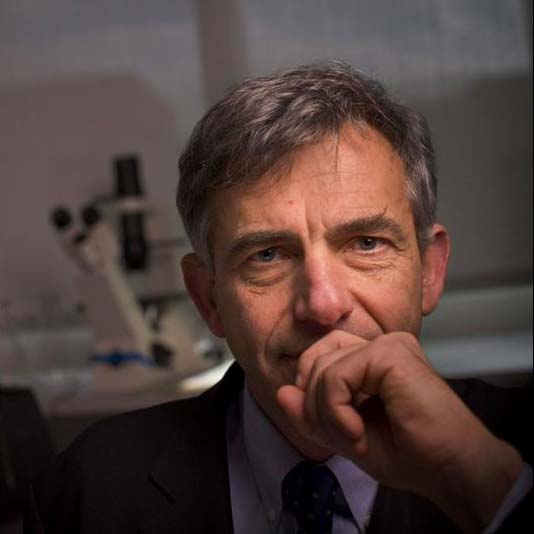
The progress of moving stem cell therapies toward clinical application and the hurdles that must be overcome along the way was the subject of a daylong discussion that took place on September 22 on the Health Sciences campus. The USC Stem Cell Translational and Clinical Sciences Research Symposium featured lectures by USC researchers Martin Pera, Michael Kahn and Ashish Ahuja, as well UC Davis professor Jan Nolta and ViaCyte, Inc. principal scientist Kevin A. D’Amour.
Kahn kicked off the proceedings, speaking on regeneration via pharmacologic orchestration of somatic stem cells. The lecture focused on how scientists can pharmacologically control a fundamental decision point in stem cell biology; basically deciding whether the stem cell makes an exact copy of itself or a more differentiated copy.
“This decision is critical to both normal physiology (general tissue maintenance) and also to pathophysiologic conditions (cancer, fibrosis, MI, neurodegeneration),” said Kahn, who discussed a number of examples of pharmacologic orchestration in animal models. “A second-generation compound will be entering clinical trials later this fall at USC, and then can be tested in patients, initially with cancer, but subsequently with other maladies.”
Dr. Pera, director of the Eli and Edythe Broad Center for Regenerative Medicine and Stem Cell Research at USC, discussed how far stem cell research at USC has come since its inception in 2006, while acknowledging the challenges that lie ahead. “The idea is to build this so we’re moving from basic research straight to treatment,” he said. “We have elements of this together, but we still have a long way to go in some respects.”
Pera acknowledged his team of leading stem cell researchers and the continuing efforts to bring the best and the brightest to USC. His presentation included a virtual tour of the $80 million building that is being prepped to house stem cell research on the Health Sciences campus. Made possible through California Institute for Regenerative Medicine (CIRM) funding and a generous gift from the Eli and Edythe Broad Foundation, the facility will open with a gala event on October 29.
Pera noted that one the most exciting endeavors he’s been involved with at USC is the California Project to Cure Blindness (CPCB), which is being led by Mark Humayun, professor of ophthalmology and cell and neurobiology at Keck. The goal of the CIRM-funded program is to bring cell-based therapy for age-related macular degeneration to clinical trial in the U.S. by 2014. Collaborating with USC researchers on this project are scientists from the University of California at Santa Barbara, The California Institute of Technology and City of Hope. Also involved are cell biologists from the University of College London.
USC’s Ashish Ahuja, executive director of operations at CPCB, explained that macular degeneration is such a promising area for stem cell therapy due to, among other factors, the eye’s immune privilege and the low number of cells required for each patient. Working in collaboration with the Doheny Eye Institute, USC researchers have developed a method of inserting substrate polymers into the back of the eye so that healthy cells can be introduced to replace dead ones.
Speaking on behalf of ViaCyte, a preclinical therapeutic company focused on diabetes, D’Amour said that finding a treatment for type 1 diabetes has been a major goal since the discovery of human embryonic stem cells. He noted that diabetes is the eighth leading cause of death in the world, affecting 246 million people worldwide — 380 million by the year 2030. He detailed the promise that cell transplant therapy holds in replacing the insulin lost to type 1 diabetes.
Rounding out the lineup of speakers were Thomas Buchanan, who spoke on translational research opportunities at USC and the role of the Clinical Translation Science Institute, and Alan Trounson of CIRM, who described the organization’s special role in funding work that bridges the transition from animal studies through early trials.
“The USC Stem Cell Translational and Clinical Sciences Research Symposium was a great success,” Pera concluded. “The poster session was indicative of the vibrant and diverse work in regenerative medicine already underway at the Keck School. Janice Liebler, Laurie Deleve and Zea Borok are to be commended for organizing this outstanding and timely symposium.”
Janice Liebler was the primary organizer for the Stem Cell Symposium. The event was made possible also through the efforts of Keck School Dean Carmen A. Puliafito and vice dean of research Elizabeth Fini.
